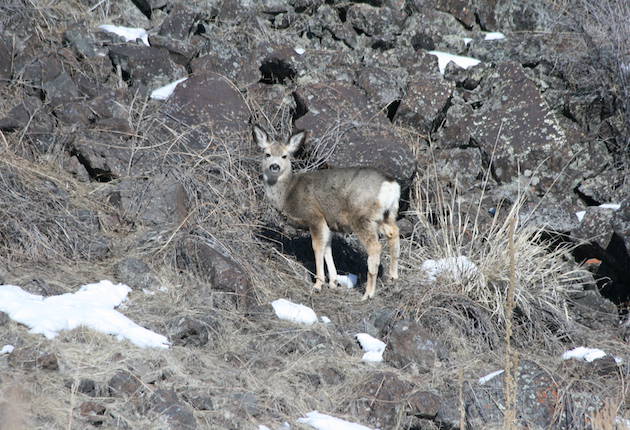“There’s animals everywhere and you don’t see that anywhere else,” says Mike Glissmeyer, the angler on snowshoes hiking next to me with his face buried in a bandana to ward of winter’s bite. “It’s great. Nothing better.”
I want to see wildlife wintering here and I want to know why this place matters to the management of Idaho’s big game herds and hunting seasons. That’s why I’m working in weather well below zero with batteries tucked in my armpits so the cold doesn’t drain them.
I have a camera pack on my back, snowshoes on my boots, and yes, frozen moisture inside my nasal passages. Extreme cold does that to you. The sun is out, but there’s no hope of thawing any time soon so I trek along with no skin exposed to avoid frostbite.

The Snake River winds through the frozen landscape of eastern Idaho. (Kris Millgate/tightlinemedia.com)
Moving keeps my blood pumping, but I can’t help stopping in my tracks to watch a pair of trumpeter swans float by. They gracefully glide by on the far side of the river while a moose casually munches willow on the bank in the background.
It’s so quiet I can hear the crispy chunks of water rubbing in the river. That’s the sound of nature’s beauty icing up in downstream swirls. I see frosty foliage, steamy current, and furry animals. A lot of furry animals. Their winter coats are thick. So is the fat on their backs. Closing the canyon to vehicle traffic in the winter helps wildlife hold on to that fat.
“We want to reduce the amount of stress from being chased or harassed,” says Daryl Meints, Idaho Department of Fish and Game wildlife manager. “Just leave them be as far as we can so they don’t have to unnecessarily burn those fat reserves to help them get through the winter.”
The ridges running along the canyon are situated perfectly for easy access to sunny, south-facing slopes. As a result, hundreds of big game animals — deer, elk, moose — are enticed to migrate along the route when cold weather comes.
Winter billowed in three months ago. These animals have at least three more months to go. This is make-or-break season in the canyon for the largest mule deer fawns in the state. The fall fat on their backs holds them well up until now. As that reserve shrinks, the exposed south slopes of grass fill in the gap until spring thaw greens more groceries.
“There’s no doubt that over time they’re big and they’re strong,” Meints says. “They’ve adapted over time because that’s the conditions they have to face if they’re going to survive an eastern Idaho winter.”
The fawns are born of rugged terrain and relentless winters, and it shows in their sturdy, unstarved stature. Proof that winter survival really is for the fittest.
Millgate is an outdoor journalist based in Idaho Falls, Idaho. See more of her work at tightlinemedia.com.

